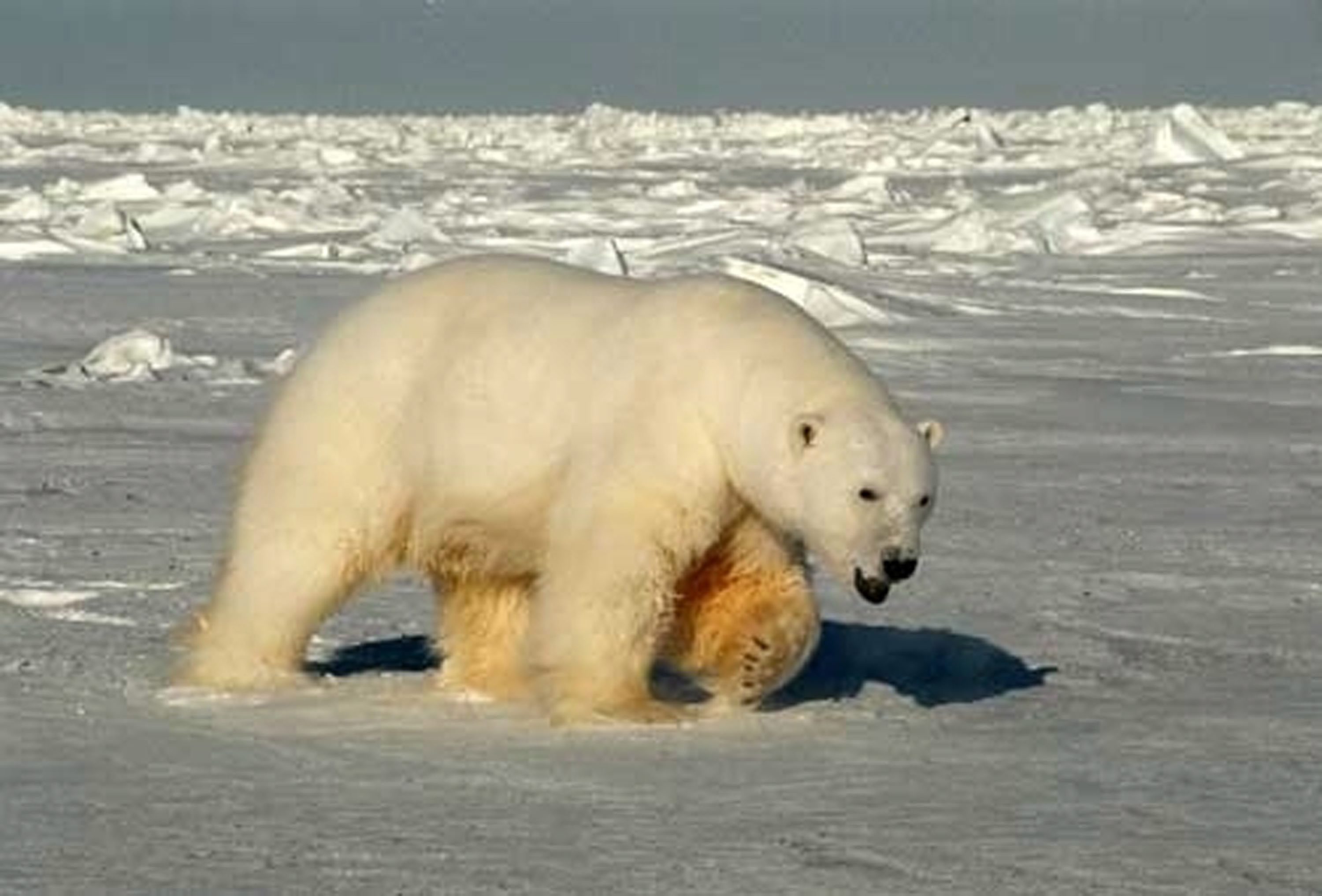Scientists seek cause of patchy baldness in some Beaufort Sea polar bears

Stressed-out polar bears in the southern Beaufort Sea are losing some of their hair, but the precise cause of that stress is yet to be determined, according to a new study published online in the Journal of Wildlife Diseases.
Scientists from the U.S. Geological Survey and Alaska Department of Fish and Game and Alaska veterinary pathologist Kathy Burek-Huntington collaborated on the study, which tracked the incidence of what is known as alopecia syndrome among southern Beaufort polar bears from 1998 to 2012.
Over the study period, 3.45 percent of the bears examined had alopecia syndrome — patchy loss of guard and underlying hairs around the head, neck and shoulders, accompanied by crusty lesions on the exposed skin. The incidences peaked in 2012, when 28 percent of the examined polar bears had the problem. That was at about the same time a mysterious affliction, with patchy fur loss and bleeding skin lesions, sickened hundreds of Arctic Alaska seals, killing many of them. The affliction was seen among some walruses as well but was less severe.
Stress response
Beaufort Sea bears with alopecia syndrome were in generally poorer shape than other polar bears, leading to a question: Did stress cause the hair loss, or did the loss of hair — part of polar bears’ protection against the cold — cause the stress that resulted in deteriorated body condition?
“That’s a question that we can’t answer at this point because we don’t know what’s causing it,” said Todd Atwood, a USGS wildlife biologist and lead author of the study.
The results were drawn from the 1,421 live polar bear captures over the period by scientists monitoring southern Beaufort Sea polar bears. The same bears were sometimes captured and sampled in different years, and in those cases, bears stricken with alopecia syndrome had recovered when found in subsequent years. There were some years when none of the captured polar bears had alopecia syndrome, and some years, like 2012, with relatively high rates.
Among polar bears that do develop bald spots, patterns emerged.
Prudhoe Bay
Most affected, the study found, were subadults. Males were more affected than females. And incidences were clustered around Prudhoe Bay — possibly a misleading result, since that was “kind of the middle of our study area,” Atwood said — with smaller clusters around Barrow and Kaktovik.
Loss of hair means more exposure to the cold, meaning affected bears might have more energy needs, Atwood said. “They might be more energetically stressed, and then they encounter some other stressors,” he said.
The scientists took skin biopsies from exposed areas and did not find evidence of bacterial or fungal infection, Atwood said.
Not affected by alopecia syndrome, the study found, were maternal bears and their cubs. That suggests the afflicted bears are encountering something in the environment during the November-to-March period, when maternal bears and their cubs are denning, the study said.
Alopecia syndrome in the North
Alopecia syndrome has not been much reported outside of the southern Beaufort Sea population, Atwood said. Bears in Canada’s Hudson Bay area have been seen with hair loss around their feet, but that is believed to result from the bears’ own grooming habits in response to accumulating ice balls.
In general, the southern Beaufort population — one of 19 polar bear population groupsin the world — is facing tough conditions. Loss of summer and fall sea ice has taken a toll on the southern Beaufort population, which fell dramatically in numbers and in reproductive success from 2001 to 2010, and on their primary prey, ringed seals.
“I think it’s a tough area for polar bears and for ringed seals,” Atwood said.
The Beaufort Sea’s continental shelf is fairly small, meaning ready access to the best marine food is more limited than in other parts of the Arctic, especially as seasonal ice cover retreats to the north, he said. The Chukchi Sea, in contrast, has a broad continental shelf — remnants of the land bridge that once united North America and Asia — so even if floating ice is sparse, polar bears and other marine mammals have far more shallow-water territory in which to hunt for food, he said.
Chukchi polar bears, though also coping with reduced summer and fall sea ice, continue to be large in body size, healthy and robust, according to a USGS study published about a year ago in the journal Global Change Biology.
Further analysis of the Beaufort bears’ alopecia problems is planned, Atwood said.
Related stories from around the North:
Canada: Star of acclaimed Inuit-language film shoots polar bear in self-defence, CBC News
Norway: Arctic Norway needs polar bear spotter, The Associated Press
Russia: Putin ensures Arctic militarization will not harm polar bears, Barents Observer
Sweden: Sweden’s mountain hares changing fur color too early, Radio Sweden
United States: Polar bears sniff pawprints to find clues about potential mates: study, Alaska Dispatch




that ws unespected and interesting. I am baldness and i used finasteride for a year and then i stopped because health issues. Great content. Thanks.
Stress has been assigned as cause one of the causes of baldness in men since long ago, but this is the first time I see it assigned to baldness in bears. 😉
Nice to know it, though.
Very interesting. If even polar bears suffer from alopecia, these studies need to go deeper. Nature always has much to teach us.
Of that I did not know. If even polar bears suffer from alopecia, these studies need to go deeper. Nature always has a lot to teach us.
Interesting article for anyone who is looking for this subject.
We can see that animals suffer about stress like human, but the difference is our mind. We have to use our mind to solve this problem, make therapy and know yourself, and then we can just help animals.
Peace
Many people think that this would be an unnecessary matter, but if nobody to observe this kind of situation as our animals in the world? I really loved this